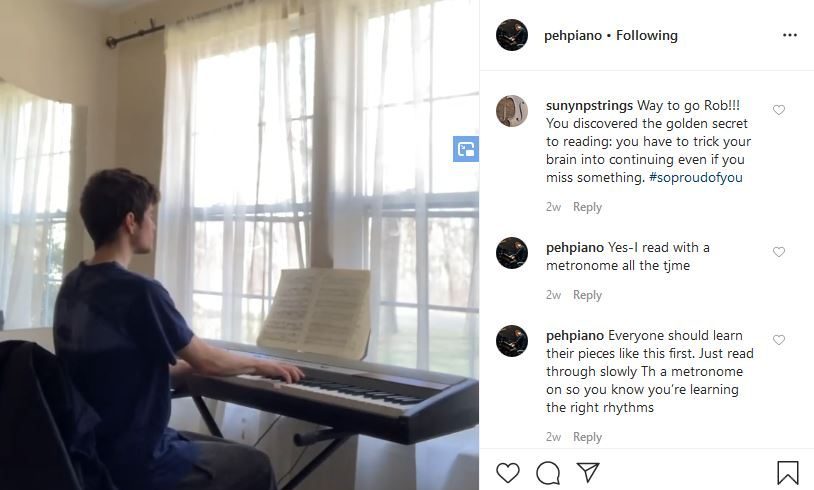How do you teach music performance remotely? Harness technology, and be creative
 Faced with the daunting task of teaching instruments from a distance, SUNY New Paltz Department of Music faculty have gotten crafty with free software and sharing platforms to keep the music alive.
Faced with the daunting task of teaching instruments from a distance, SUNY New Paltz Department of Music faculty have gotten crafty with free software and sharing platforms to keep the music alive.
Assistant Professor Alex Peh has taken to Instagram TV to teach his piano students. On a private account, his student musicians post videos of themselves playing each day, and he provides feedback by commenting under the videos.
The posts give an intimate glimpse into the students’ creative spaces at home. Some zoom in on their fingers dancing across the keys, and others have added fun animations to the backgrounds of their videos.
“While most people are teaching lessons via WebEx or Zoom, I find Instagram to be more powerful in creating a sense of community through all this,” said Peh.
Adjunct piano lecturer Tristan McKay said the move to distance learning has inspired faculty to supplement practical work with written assignments that connect theory and performance. He records lecture videos to prompt student responses and offers “weekly mini-lessons” over FaceTime or Skype.
“While nothing can replace the importance of in-person instruction for learning a musical instrument, the necessary move to remote learning has offered us the chance to explore music performance in a wider context,” said McKay.
While solo performance and instruction lend themselves well to social media, collaborative ensemble performance has proven to be a bit trickier—but doable and fruitful nonetheless.
Rich Syracuse, adjunct lecturer in the Department of Music, has experience instructing students remotely, but he admits that coaching his chamber jazz ensemble has presented a challenge in a distance learning environment.
“It’s a music-making operation,” said Syracuse of the jazz ensemble, “and there really isn’t any technology that exists today where you can bring three or four, let alone 12 or 13, people to make music together in real time. So the challenge was: How do I make music with these folks?’”
With guitarists, bassists, trumpet players, saxophone players and jazz vocalists under his wing, Syracuse invited his students to use GarageBand, a free, open-access application, to overcome the distance and make music together.
“Most people in the recording industry don’t take GarageBand seriously at all, but I’ve been experimenting with it for teaching for maybe a decade now,” Syracuse said.
While the jazz ensemble course normally culminates in a live concert at semester’s end, Syracuse and his colleagues are instead giving students the opportunity to participate in a remote recording project.
The process is laborious: He imports written music into GarageBand, and students are assigned different portions of each song to record from home. They send their tracks back to Syracuse each weekend, and then Syracuse edits and mixes them together.
“Especially being a jazz musician—someone who is, by definition, an improviser—it’s my responsibility to provide something for my students so that they can continue to have a positive experience,” said Syracuse. “I don’t want it to be a lost semester. That just wouldn’t be right.”
Syracuse hopes the process brings students a sense of peace and enjoyment in an otherwise unfamiliar and chaotic time in their lives and academic careers.
“Music is healing,” Syracuse said. “Sound waves—being on the receiving end of it or being the person who’s creating it—is therapeutic. It’s an amazing energy. In this setting, I’m hoping it’s something [students] might find enriching.”
Visit the Department of Music online to learn more about their course offerings, distinguished faculty and programs for students.
